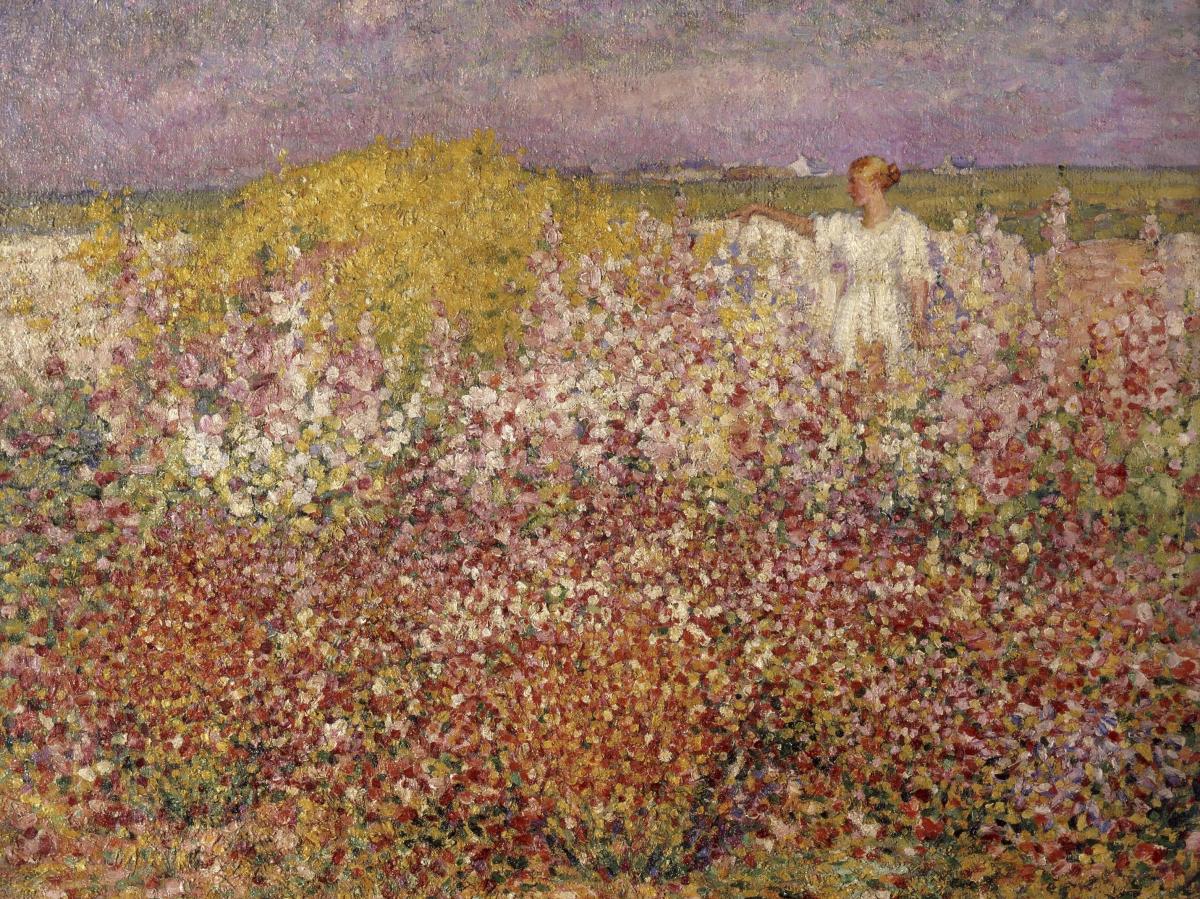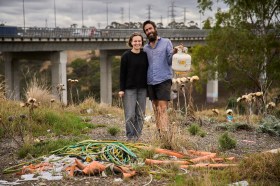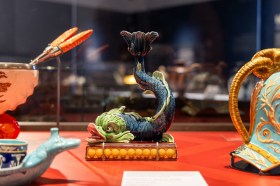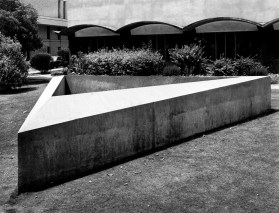John Russell, Mrs Russell among the flowers in the garden of Goulphar, Belle-Île (1907), detail; Musee d’Orsay, Paris / Musee de Morlaix
Vincent Van Gogh, Claude Monet, Auguste Rodin, Henri Matisse – household names who shaped a moment in global art history. Their works grace the halls of the world’s greatest art museums, adorn the pages of weighty tomes, tote bags and note cards – and yet among them was an Australian little known or celebrated by our own version of art history.
John Russell – Australia’s only French Impressionist – spent 40 years living and working abroad, his friendship with those great artists genuine and enduring.
Monet painted and dined with Russell when they met on Belle-Île, an island off the coast of Brittany where Russell later built a house and lived for twenty years. He commissioned Rodin to sculpt a bust of his new wife Marianna, which led to a lifelong friendship and over 60 letters between them. Van Gogh mentions Russell in 30 different letters, describing what he was doing in the context of his peers. He is even said to have taught colour theory to Henri Matisse.
Wayne Tunnicliffe, Head Curator, Australian Art and curator of a new exhibition on Russell’s work at the Art Gallery of New South Wales (AGNSW), said: ‘He was an incredibly present enigma.’
Tunnicliffe continued: ‘Russell’s capacity for friendship during a time when camaraderie was greatly valued meant his experience as an artist was fundamentally shaped by an exchange of ideas about art within a remarkable international peer group.
‘When I was researching this exhibition internationally, going to the Van Gogh Museum in Amsterdam, The National Gallery in London, the Musée d’Orsay in Paris – the curators knew of Russell and were very interested in him because he was someone who was present in Paris in the 1880s and knew he was participating in this remarkable moment, but they couldn’t find any information on him,’ Tunnicliffe continued.
John Russell left Australia to study at the Slade School of Fine Art in London in 1881. Returning the following year as an ambitious art student, he immediately wrote to the Sydney Morning Herald to complain about the lack of Australian art works on display at the AGNSW.
‘At that time,’ Tunnicliffe explained, ‘our Trustees were looking out at the world and bringing international art to Australia. There were very few opportunities for Australian artists to train here.’
A self-portrait in a worldly red fez is the earliest work in this exhibition of 115 paintings, watercolours, drawings and sculptures, of which 99 were drawn from international and Australian collections. Many of the works have not been exhibited before.
John Russell: Australia’s French Impressionist – On now until 11 November.
Tunnicliffe said his interest in Russell stemmed from a need to complicate art histories. ‘Russell is one of those artists who sits within – and without – Australian art history. While Impressionism is our most popular art movement in Australia, tied in with an emerging nationalism in the 1890s, the most Impressionist of our artists was actually in France, viewing exhibitions and responding to what he saw.
‘His experimentation, and his ability with colour, was extraordinary and was commented on at the time,’ said Tunnicliffe.

John Russell, Rough sea, Morestil (c. 1900), Collection Art Gallery of New South Wales
Tunnicliffe explained that the main reason Russell wasn’t heralded as our great Master Impressionist was because you couldn’t see his paintings here. ‘When he returned to Australia in 1921 he kept his studio in Paris where his works were locked up. And when some paintings trickled back in the 1960s they didn’t look like Australian works; we were in the middle of that nationalist moment, and they just sat uncomfortably – there wasn’t a gum tree in sight.’
Despite this, Russell was very Australian in character, and thought of himself that way. ‘He travelled at a point in time when he wasn’t bound by identity. Late 19th century Impressionism was one of those movements that had a global zeitgeist. I think it was a paradigm for that globalism we recognise today,’ said Tunnicliffe.
He added that while Russell was a big personality – he boxed, rowed on the Seine, embraced the outdoors – he was a modest man when it came to his practice. ‘He never tried to sell his work, and he only occasionally exhibited before the early 1900s.’
Given that history, it is interesting that Russell’s 1886 portrait of Vincent van Gogh is the first work visitors encounter when they enter the Van Gogh Museum in Amsterdam. In this AGNSW exhibition, it sits next to Van Gogh’s Self-Portrait with felt hat (1886-87), showing their deep connection.
These two portraits are among a number of works, including two paintings by Claude Monet, two by Henri Matisse, five sculptures by Auguste Rodin and two paintings by Tom Roberts, that reconfirm Russell’s place in art history.
AGNSW Director, Michael Brand added: ‘This is a bit of a dream project for us. We have a deep mission to understand and research Australian art and are also particularly keen to put that art in an international context.’
Russell was 63 when he eventually returned to Australia. His cousin, Thea Procter, encouraged him to engage with the art world, but he wouldn’t.
‘Australian art in the 1920s was very conservative, and maybe he felt that there was no place for his art, and he didn’t want to get out and battle to be accepted,’ said Tunnicliffe.
This exhibition recalibrates the scales of history, forming the definitive account of one of Australian art’s greatest enigmas.
John Russell: Australia’s French impressionist
Art Gallery of NSW
On now until 11 November 2018
Ticketed
Exhibition Talks: Every Wednesday, 19 September to 10 October from 5.30-6pm, and led by curators Anne Gérard Austin, Jackie Dunn and Nick Yelverton.





